[ad_1]
Nation stage variations in fires
Variations in VIIRS derived fireplace counts (FC) for various SA/SEA international locations are proven in Fig. 2a,b. MODIS and VIIRS annual fireplace detections for various years in SA/SEA international locations are proven in Desk 1a,b. On common, VIIRS may detect 5.28 instances extra fires in South Asia and 5.12 instances extra fires in Southeast Asian international locations. In South Asia, India had the best FC (µ = 555,651; SD = 71,222.0), adopted by Pakistan (µ = 55,670.3; SD = 6031.7), Nepal, Bangladesh, Sri Lanka, Bhutan, and least in Afghanistan (µ = 1063; SD = 433.9). Within the case of Southeast Asian international locations, Myanmar had the best FC (µ = 347,930; SD = 54,111.2), adopted by Indonesia (µ = 316,753; SD = 254,271), Thailand, Cambodia, Laos, Vietnam, Philippines, Malaysia, Timor Leste and the least in Brunei (µ = 209; SD = 110.5). At a rustic stage in SA, the coefficient of variation (CV) in FC (2012–2020) was comparatively excessive for Nepal (CV = 0.59), Bhutan (0.54), Sri Lanka (0.32), Bangladesh (0.27), Afghanistan (0.20), India (0.12) and least for Pakistan (0.11). In SEA, the best CV was discovered for East Timor (141.9), adopted by the Philippines (114.17), Brunei (109.0), Singapore (108.31), Cambodia (103.50), Malaysia (94.29), Myanmar (87.51), Indonesia (86.21), Laos (80.37), Thailand (4846) and least for Vietnam (25.33).
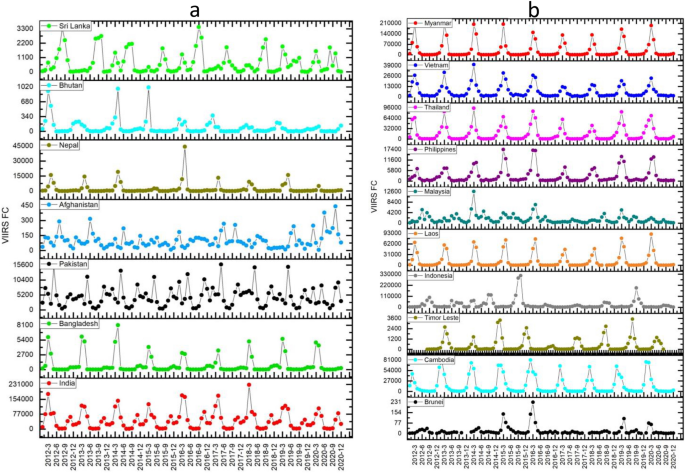
(a), (b) VIIRS (375 m) retrieved fireplace counts (FC) for South and Southeast Asian international locations.
The burnt areas (BA’s in sq. km) inter-annual variability derived from MODIS MCD64A1 (500 m) product for various SA/SEA Asian international locations from 2000–2020 are given in Fig. 3a,b. In South Asia, India had the best BA (µ = 37,226; SD = 14,470.1), adopted by Pakistan (µ = 1733; SD = 811.5), Nepal, Bangladesh, Sri Lanka, Afghanistan, and least in Bhutan (µ = 63; SD = 55.9). Within the case of SEA international locations, Myanmar had the best BA (µ = 31,204; SD = 13,033.4), adopted by Cambodia (µ = 24,348; SD = 7010.3), Thailand, Indonesia, Vietnam, Laos, Philippines, Malaysia, Timor Leste, and least in Brunei (µ = 1.70;SD = 2.0).
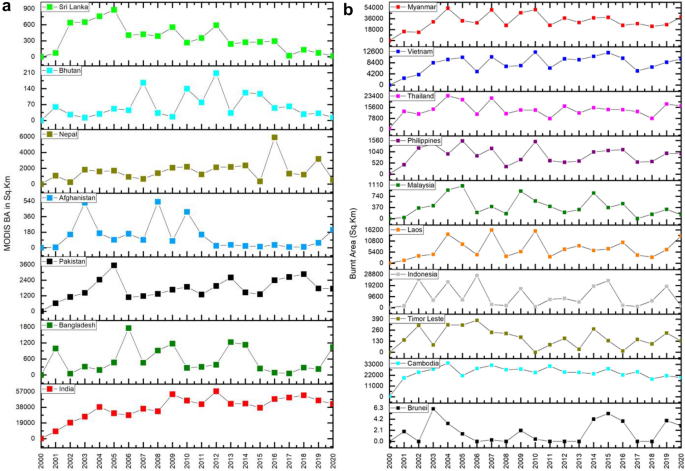
(a), (b). Burnt areas (in sq.km) for various international locations in South Asia (10a) and Southeast Asia (10b).
Along with the full BA for particular person international locations, inter-annual variability in BA in numerous land cowl courses from 2000–2020 are additionally proven for various international locations in South Asia and Southeast Asia (Supplementary supplies Figs. 1a,b,c,d,e,f,g and 2a,b,c,d,e,f,g,h,i,j). A better have a look at the BA in South Asian international locations suggests a comparatively larger proportion in croplands for India (68.8%), Pakistan (96%), and Sri Lanka (88%) in comparison with forest fires in Bhutan (82%) and Nepal (84%). Additionally, an obvious enhance in cropland fires could be seen from 2000–2020 in India and Pakistan in comparison with Sri Lanka. In SEA international locations, Myanmar (62.7%) and Cambodia (73.4%) had probably the most burnt areas in forests, whereas the remainder of the international locations, i.e., Laos, Indonesia, Thailand, Vietnam, Malaysia, and so on., had probably the most burnt areas in croplands.
Hearth variations Pre-COVID and COVID 12 months
Outcomes of year-to-year adjustments in FC for COVID-2020 versus 2019 for SA/SEA international locations are proven in Desk 2a,b. Apart from Afghanistan, Sri Lanka, and Bangladesh, which had FC will increase of 152%, 4.85%, and 0.81%, respectively, throughout COVID-2020 in comparison with 2019, all different international locations had a decline in FC, with the most important decline in Nepal (− 73%), Bhutan (− 20%), India (− 11.48%), Pakistan (− 3.38%) (Desk 2a). Amongst the Southeast Asian international locations, Cambodia (11.1%), Myanmar (8.5%), and Laos (2.78%) had a rise in fires throughout COVID-2020 in comparison with 2019. In distinction, there was a decline in Indonesia (− 79%), Malaysia (− 53%), Timor Leste (− 43%), and so on. (Desk 2b). Spatial variations in p.c FC enhance or lower throughout 2020 versus 2019 for the 0.5° gridded information are proven in Fig. 4. Outcomes recommend the best p.c enhance in fires in Afghanistan, Pakistan, and northern Himalayan mountain ranges extending to Nepal with a comparatively smaller enhance in Jap Ghats of India, in South Asia. Whereas, in Southeast Asia, Northeast Myanmar, Southern Laos, Southeast Vietnam, Aceh, North-Western Sumatera, northern Kalimantan, Papua-New Guinea in Indonesia confirmed comparatively larger fires throughout COVID-2020 versus 2019.
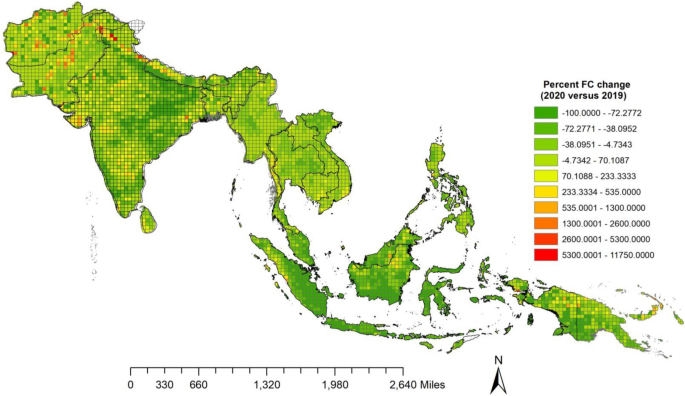
P.c FC change throughout 2020 versus 2019 for South/Southeast Asia. VIIRS I-band (375 m) fireplace counts had been spatially gridded at 30 min intervals (0.5 × 0.5degree cells) for the regional scale evaluation. A transparent p.c enhance in fires could be seen in northern Himalayan area, southern Vietnam, Western Indonesia together with northern Kalimantan and Papau New Guinea (Map created utilizing QGIS ver.3.22)
P.c enhance or lower in FC for COVID-2020 12 months versus pre-pandemic years (2012–2019) for SA/SEA international locations are proven in Desk 3a,b. Outcomes recommend that apart from Afghanistan and Bangladesh, which had a rise in FC of 102.5% and eight.05% throughout COVID-2020 in comparison with earlier years (2012–2019), the remainder of the international locations had a decline in FC, with the most important decline in Nepal (− 70%), Bhutan (− 57%), and so on. Within the case of SEA international locations, a rise in FC throughout 2020 as in comparison with the imply FC in earlier years (2012–2019) was discovered for Laos (30.2%), Thailand (21.1%), Myanmar (18.72%), Philippines (13.03%), and Cambodia (7.14), whereas most declines in FC had been discovered for Indonesia (− 74%), Malaysia (− 54.1%), and so on. Spatial variations in p.c FC enhance or lower throughout 2020 versus earlier years (2012–2019) for the 0.5° gridded information are proven in Fig. 5. A rise in fires could be seen in central and north Western Afghanistan, Central and Western Pakistan, Western and Central India stretching south, northern West Bengal, and Southern Sri Lank in South Asia. In Southeast Asia, Western Cambodia and Southern Myanmar, Southern Laos, Northern Vietnam, each north and the southern Philippines, northern Kalimantan, and Papua New Guinea of Indonesia confirmed comparatively extra fires throughout 2020 than in earlier years (2012–2020). General, South Asia’s imply lower in fireplace counts throughout COVID-2020 in comparison with 2019 was − 13.23%, whereas 2019 versus earlier years (2012–2018) was solely − 6%. Equally, for the Southeast Asian international locations, the imply decline in fireplace counts throughout 2020 in comparison with 2019 was − 25.0%, whereas 2019 versus earlier years (2012–2018) was solely − 16%. The brand new information concerning the presence of fires constantly (2012–2020) in numerous areas may also help native governmental authorities to accentuate their remedial measures and design future methods for more practical fireplace management. For instance, fireplace pre-suppression determination necessities are geared toward allocating sources resembling firefighting funds, personnel, and tools. In such a context, the hotspot areas of fires recognized on this examine may also help in fireplace administration and management.
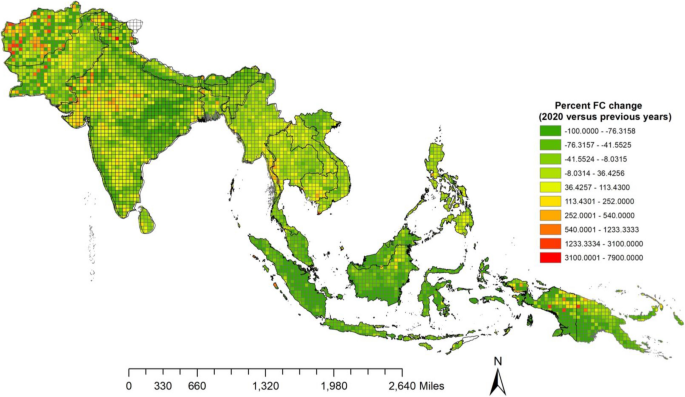
P.c FC change throughout 2020 versus earlier years (2012–2020) for South/Southeast Asia. VIIRS I-band (375 m) fireplace counts had been spatially gridded at 30 min intervals (0.5 × 0.5degree cells) for the regional scale evaluation. A transparent p.c enhance in fires could be seen in Afghanistan, Western Pakistan, northern Himalayan area, Central India extending in direction of south, southern Laos, western Cambodia, Philippines, northern Kalimantan and Papau New Guinea, Indonesia (Map created utilizing QGIS ver.3.22).
Outcomes from the Z-score evaluation recommended vital variations at a rustic stage and spatial stage (30-min grid cells) (Fig. 6). The unique information of FC for 2020 are additionally proven in Fig. 7. For instance, the long-term (2012–2020) information evaluation in SA recommended a decline in FC for the 2020 pandemic 12 months for Bhutan (Z = − 1.02), India (− 1.04), Nepal (− 1.06), Pakistan (− 0.58), Sri Lanka (− 0.24) and enhance for Afghanistan (+ 2.30) and Bangladesh (0.30). In SEA, East Timor (− 0.50), Indonesia (− 0.89), Malaysia (− 1.07), Singapore (− 1.2), and Vietnam (− 0.40) had a decline in fires, and Cambodia (Z = 0.44), Laos (1.37), Myanmar (1.07), Thailand (0.77) and Philippines (0.07) had a rise in fires. In comparison with country-level, a number of patches in S/SEA confirmed a lower in fires for 2020 pandemic 12 months in comparison with long run 2012–2020 pre-pandemic report, with Z scores larger or lower than two denoting statistical significance. Spatially, the lower in fires with Z-score could be seen within the Jap and Western components of India, Northeast India, Northern Myanmar, southern Laos, northern Cambodia, and most components of Indonesia. However, the rise in FC could be seen in Central and Southern India, southern Myanmar, northern Thailand, and Southern Cambodia.
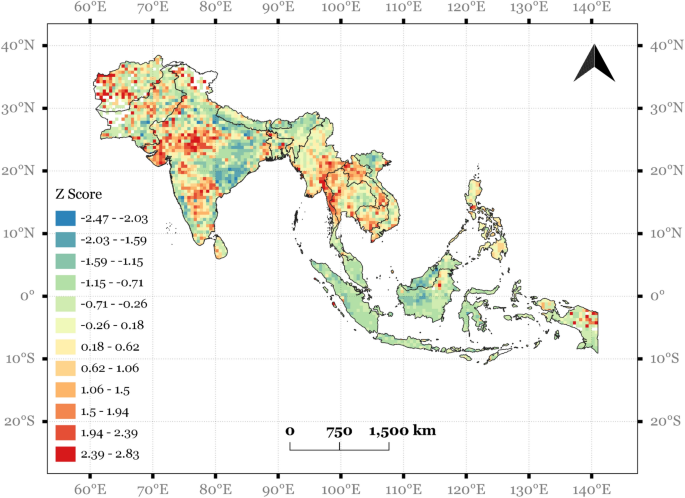
Z-score map of fireplace counts (FC) for 2020 pandemic 12 months derived from VIIRS fireplace information from 2012–2020. The unfavourable scores point out locations the place there was decreased FC and optimistic values point out elevated FC (Map created utilizing QGIS ver.3.22).
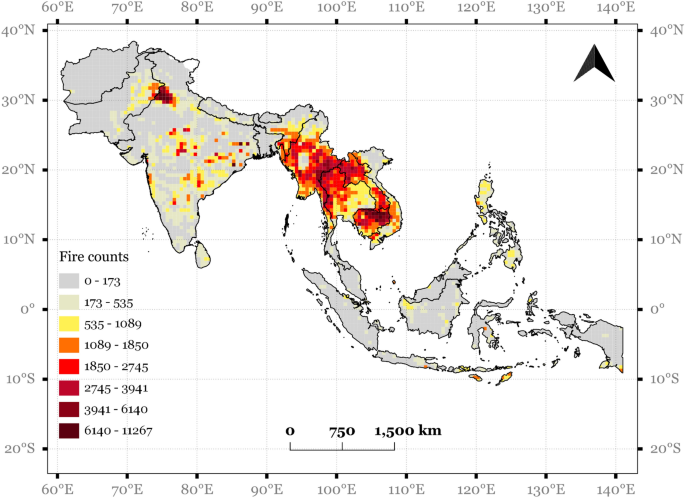
Hearth counts (FC) for 2020 pandemic 12 months derived from VIIRS fireplace information (Map created utilizing QGIS ver.3.22).
Hearth and local weather variations
To deal with whether or not local weather parameters affect the fires, we additionally analyzed the fireplace information relationships with the imply month-to-month temperature (deg.C) and precipitation (mm) for South/Southeast Asia international locations from 2012–2020 Figs. 8a,b,c,d,e,f,g, 9a,b,c,d,e,f,g and 10a,b,c,d,e,f,g,h,i,j, 11a,b,c,d,e,f,g,h,i,j respectively. In most South/Southeast Asian international locations, fire-temperature and fire-precipitation correlations had been poor. For instance, solely Afghanistan confirmed a comparatively larger optimistic coefficient of willpower (R2 = 0.121) in South Asia, and the others confirmed poor correlations. Though fire-precipitation plots had a unfavourable slope in South Asia international locations, the correlations had been poor. Within the case of Southeast Asian international locations, too, fire-temperature correlations had been poor. Comparatively, fire-precipitation relationships confirmed larger unfavourable correlations than temperature. For instance, fire-precipitation coefficient of willpower (R2) in Indonesia was 0.22, Thailand (0.19), Vietnam (0.18), Myanmar (0.14), Malaysia (0.11), Cambodia (0.10). For the remainder of the international locations, the correlations had been poor. As well as, we additionally analyzed the temperature (in °C) variations through the peak biomass burning months to deduce anomalies at a rustic scale for 2019 and 2020. Temperature information for various international locations are given within the supplementary supplies. In South Asian international locations, Afghanistan confirmed a big enhance in fires throughout 2020 with a corresponding enhance in temperature (~ 0.55 °C throughout 2020), whereas the remainder of the international locations had a lower in fires with a corresponding lower in temperature (< 1.0 °C throughout 2020). In Southeast Asian international locations, besides Cambodia and the Philippines, which confirmed elevated fires with rising temperatures (0.29 and 0.41 °C, respectively) from 2019 to 2020, the remainder of the opposite international locations did not present such a relationship. Nevertheless, the long-term (2012–2020) fire-precipitation correlations weren’t robust in these international locations. Additionally, Laos, Myanmar, and Thailand had a rise in fires however a lower in temperature.
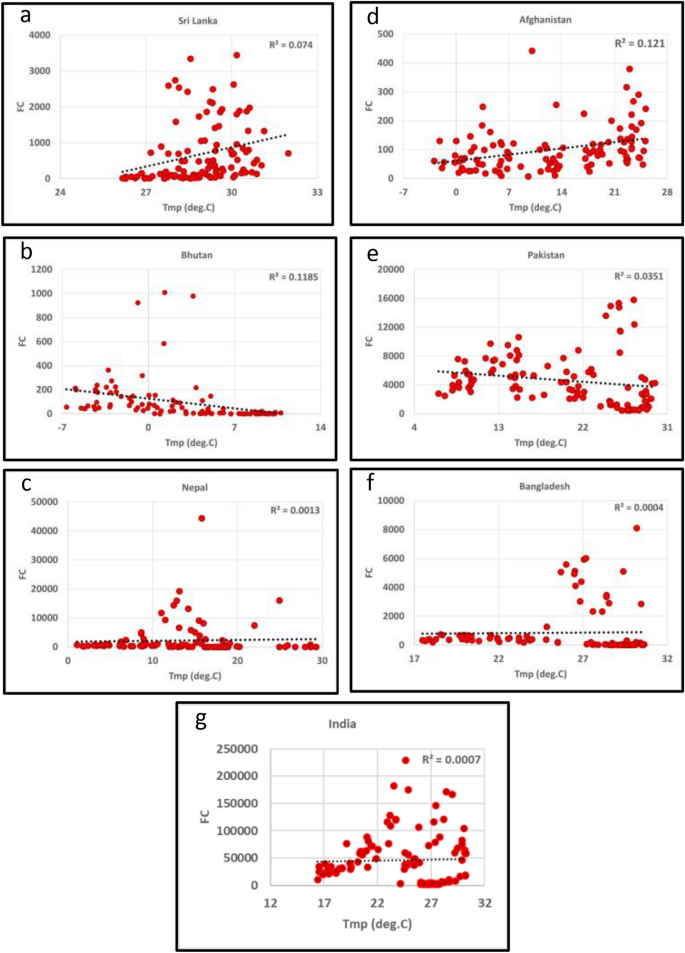
(a)–(g) Hearth Counts (FC)-Temperature (Tmp) relationships in South Asian international locations. A lot of the correlations had been poor.
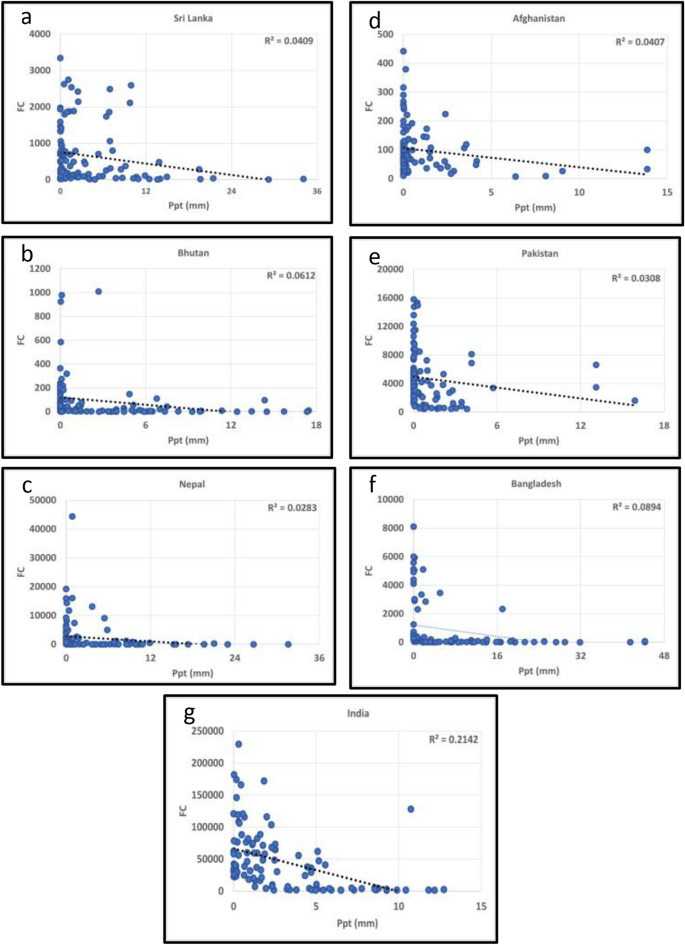
(a)–(g) Hearth Counts (FC)-Precipitation (Ppt) relationships in South Asian international locations. A lot of the correlations had been poor.
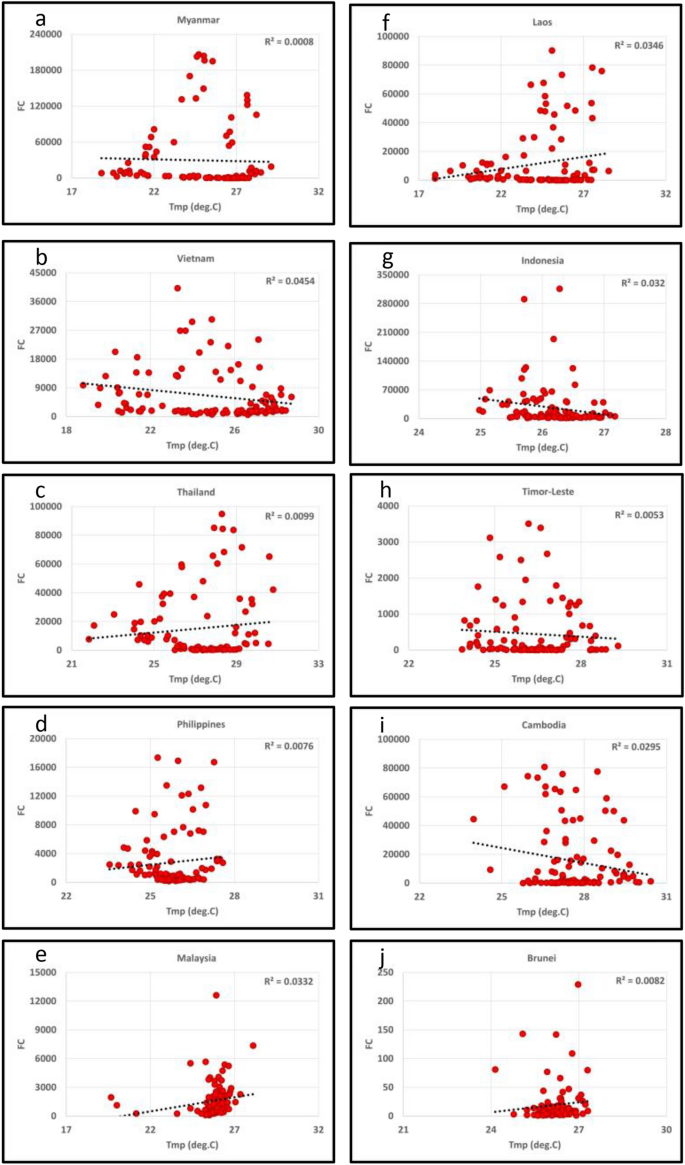
(a)–(j) Hearth Counts (FC)-Temperature (Tmp) relationships in Southeast Asian international locations. A lot of the correlations had been poor.
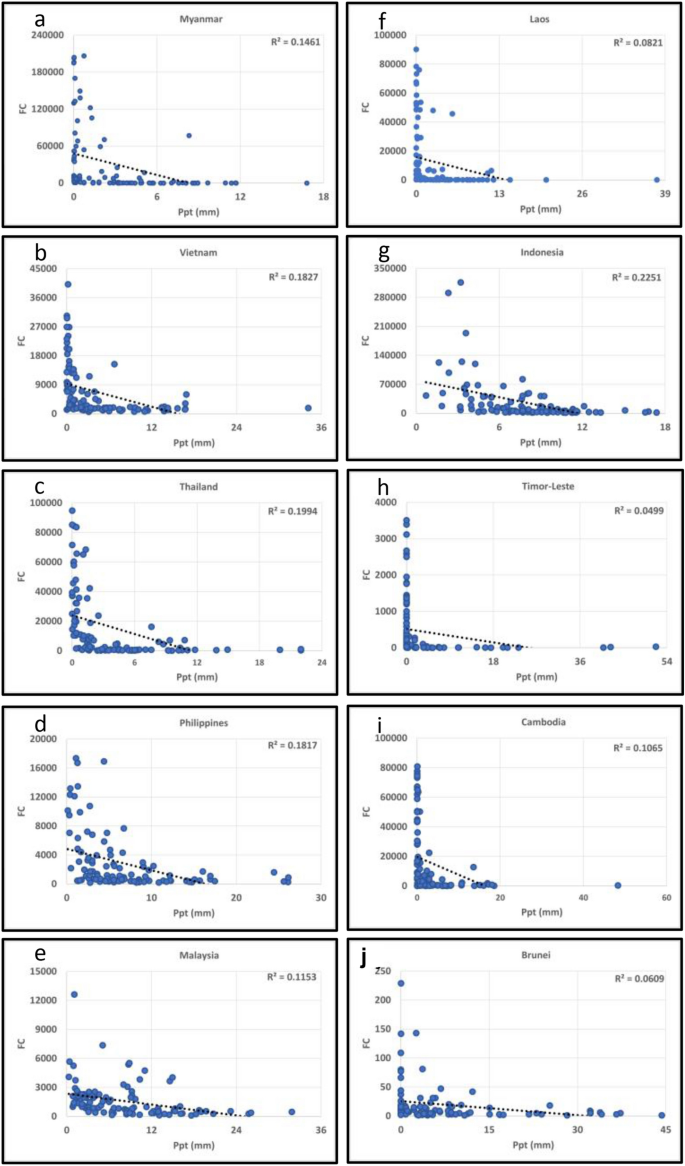
(a)–(j) Hearth Counts (FC)-Precipitation (Ppt) relationships in Southeast Asian international locations. A lot of the correlations had been poor, nevertheless, comparatively, FC confirmed larger coefficient of willpower with precipitation than temperature.
Fires and emissions
Outcomes on the TPM emissions (in Tg) for various SA international locations are proven for 2012–2019, 2019, and 2020 in Fig. 12a,b,c. Outcomes recommend a imply of ~ 2.31 Tg TPM for 2012–2019 from the South Asian international locations. Of the two.31Tg, ~ 86% is contributed by India, adopted by Pakistan (6.64%), Bangladesh (3.1%), Nepal (2.6%), Sri Lanka (1.2%), and Afghanistan (0.18%). For 2019, the full TPM from South Asian international locations is about 2.19Tg, i.e., 0.11Tg lower than the imply TPM emissions from earlier years. Additional, in 2020 the full TPM was about 2.05Tg, i.e., 0.261 lower than the earlier years and 0.14Tg lower than 2019. General, in comparison with TPM emissions in 2012–2019, when it comes to p.c decline throughout 2020, Nepal had the best drop (− 67.2%), adopted by Bhutan (− 54.6%), Pakistan (− 13.7%), whereas Afghanistan and Bangladesh had a rise in TPM of 127% and 31% throughout 2020.

(a)–(c) Complete Particulate Matter (TPM) emissions (Tg) from South Asian international locations. (a). Imply TPM (Tg) throughout 2012–2019; (b). 2019-non COVID 12 months; (c). 2020-COVID 12 months. A discount in TPM emissions has been noticed throughout COVID-2020 for a lot of the international locations, besides Afghanistan and Bangladesh. 2020-COVID 12 months had an general discount of ~ 0.26 Tg TPM emissions in comparison with earlier non-COVID years and 0.14 Tg lower than 2019 non-COVID 12 months.
Outcomes on the TPM emissions for various SEA international locations are proven for 2012–2019, 2019 and 2020 in Fig. 13,a,b,c. Outcomes present a imply of ~ 6.83 Tg TPM for 2012–2019 from the Southeast Asian international locations. Of the full 6.83 Tg, ~ 26% is contributed by Myanmar adopted by Indonesia (23.4%), Laos (22.4%), Cambodia (10.61%), Thailand (8.59%), Vietnam (5.34%), Philippines (1.81%), Malaysia (1.27%), Timor Leste (0.23%) and Brunei (0.01%). For 2019, the full TPM from Southeast Asian international locations is about 7.47Tg, i.e., 0.64Tg larger than the imply TPM emissions from earlier years. Additional, for 2020, the full TPM was about 5.716Tg, i.e., 1.11Tg lower than the earlier non-COVID years and 1.75Tg lower than 2019. General, evaluating TPM emissions throughout 2012–2019 to 2020, Indonesia had the best decline (− 78.59%), adopted by Malaysia (− 64.0%), Timor Leste (− 24.9%), and so on., whereas the Philippines had a rise of 13.9% in TPM emissions adopted by Myanmar (6.70%), Laos (11.0%), Cambodia (3.60%). Additional, a comparability of TPM emissions recommended comparatively larger emissions from Southeast Asian international locations (5.71 Tg) than South Asian international locations (2.05Tg) throughout 2020.
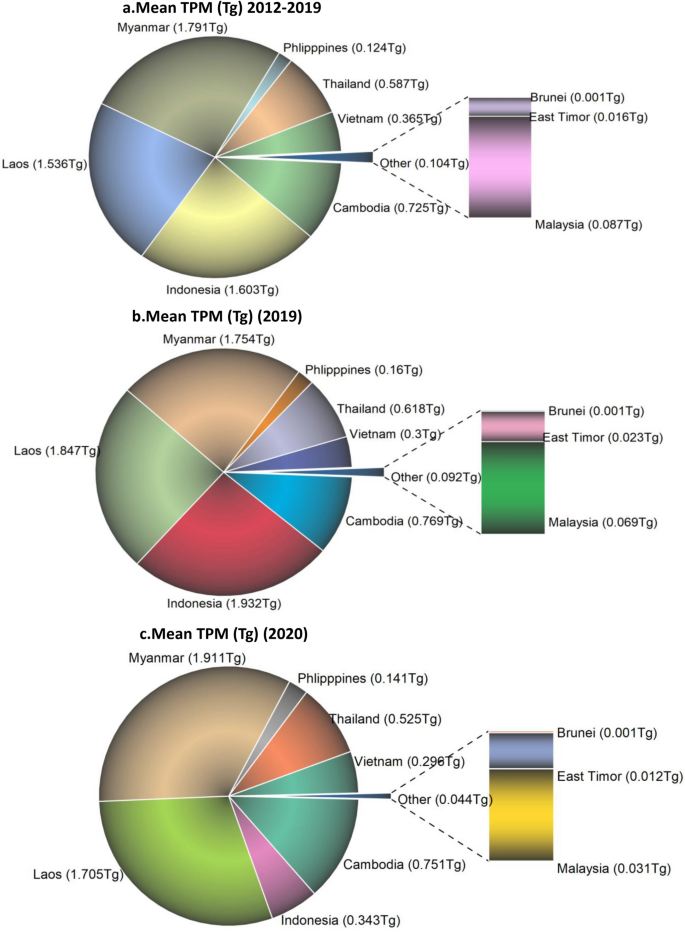
(a)–(c) Complete Particulate Matter (TPM) emissions (Tg) from Southeast Asian international locations. (a). Imply TPM (Tg) throughout 2012–2019; (b). 2019-non COVID 12 months; (c). 2020-COVID 12 months. A discount in TPM emissions has been noticed throughout COVID-2020 for a lot of the international locations, besides Myanmar, Laos, Cambodia and Philippines. 2020-COVID 12 months had an general discount of ~ 1.11 Tg TPM emissions in comparison with earlier non-COVID years and 1.75 Tg lower than 2019 non-COVID 12 months.
[ad_2]
Supply hyperlink